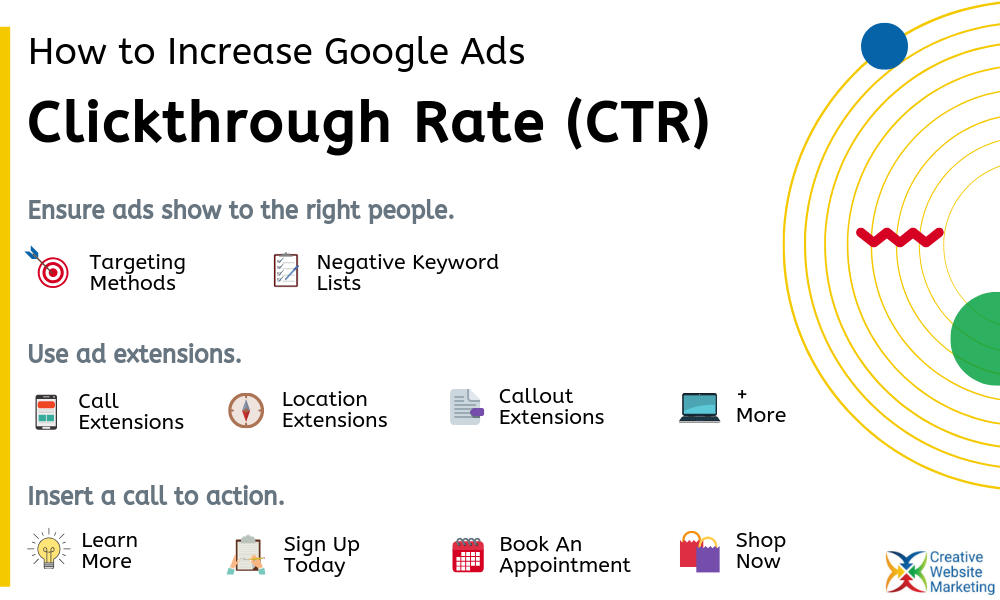Wondering how to increase your clickthrough rate (CTR) in Google Ads? Below, we’ll walk through three strategies to boost your CTR:
- Make sure the right people see your ad by using targeting and negative keywords
- Utilize ad extensions
- Insert a strong call to action (CTA)
First, though, let’s start with the basics.
What is Click-Through Rate?
Sometimes called interaction rate, clickthrough rate (CTR) in Google Ads measures how often the people who see your ad actually end up clicking on it. Google determines this by the formula: Clicks / Impressions.
But what does CTR mean in the context of your PPC campaign? Basically, this metric indicates whether or not your ads are enticing users to click through to your site.
The average CTR varies by industry. To view industry benchmarks and see how your CTR compares, check out this list from WordStream of average click-through rates in Google Ads by industry.
What does a low CTR mean?
Is your CTR low compared to industry averages? A below-average CTR signals a few things.
The good news is that your ads are getting impressions. This means that you’ve done a good job with bidding, keyword selection, and other factors that determine whether or not your ads show up on the Google search engine results page (SERP).
However, even though users are seeing your ad, they are not clicking it. When your goal is to drive traffic to your website, this is a problem.
Luckily, there are strategies to help increase CTR in your PPC campaigns. Often, it only takes a few tweaks to see improvement.
How can I increase CTR in my Google Ads account?

1. Make sure the right people see your ad
When running a Google Ads campaign, you want your ad to show up, but not to everyone. Ideally, Google should only show your ad to your target audience– people likely to be interested in and engage with your brand.
Targeting is a powerful and easy tool to ensure your ads reach the right users. Google Ads offers a variety of targeting methods, from location targeting (also called geo-targeting) to targeting by demographics and income level.
More advanced options like remarketing and custom intent audiences let PPC advertisers further hone in on their target audience.
For search campaigns, negative keywords are another method for weeding out irrelevant searches that may trigger your ads. You can use the Search Terms Report in Google Ads to see what search queries have caused your ads to appear on the SERP.
If you see irrelevant terms that don’t align with your products or services, add them to your negative keyword list. Once you do that, your ads will no longer show up for search queries that include those negative keywords.
So how do targeting and negative keywords help CTR? When your ads stop appearing to users with no interest in your product, and start appearing to the people they’re meant to engage, your CTR will undoubtedly improve.
2. Use ad extensions
Extensions can help boost your Google Ads CTR in several ways. First, extensions increase the real estate your ad takes up on the SERP. Your ad becomes more dominant on the page, making users more likely to notice, read, and click the ad.
Plus, ad extensions provide additional information about your business beyond your ad’s headlines and descriptions. Any piece of this added information may resonate with a consumer, enticing them to click through to your site when they may have otherwise kept scrolling.
Furthermore, because ad formatting factors into Quality Score, utilizing ad extensions can also help boost ad rank. The higher you rank on Google, the more likely users are to click on your ad.
In fact, according to Google, there is on average a 10-15% increase in CTR after implementing a new ad extension.
This varies by industry and other factors, of course. For instance, PPC Hero ran a test where they added callout extensions to an eCommerce account in Google Ads. In just 30 days, this led to a staggering 221% increase in CTR.
Although this won’t be the outcome for every campaign that uses extensions (if only!), data supports the value of this ad formatting option.
However, don’t stick an extension onto your ad just to have it there. Be intentional about which extensions you apply, and know the value it brings to your target audience.
For example, learn about the 5 ad extensions we recommend to help increase your CTR.
3. Insert a call to action
We are huge advocates for including a call to action (CTA) in your ad. This may seem like common sense, but it can be easy to focus your ad copy so much on your product or service that you overlook including a CTA.
It’s crucial to direct your audience to take the next step in their customer journey. In order to do that, you must clearly state what the step is. For example:
- Shop Now
- Learn More
- Visit Us Today
- Sign Up Now
- Schedule An Appointment
- Download Your Free Ebook
Include your CTA in the headline, and reiterate it in the description. Make it clear to the customer that you can meet their needs, and illuminate the action they need to take in order to obtain your product or service.
When you encourage the user to take a concrete action, he or she is more likely to follow through and click on your ad– leading to increased CTRs.
And of course, once you win the click from users, you want to be sure your landing page is designed to convert.
Need more help optimizing your PPC campaigns? Learn about our PPC Management services here.
Creative Website Marketing is a digital marketing agency in Nashville, TN, helping businesses throughout the country execute strategic brand awareness + lead generation efforts.

